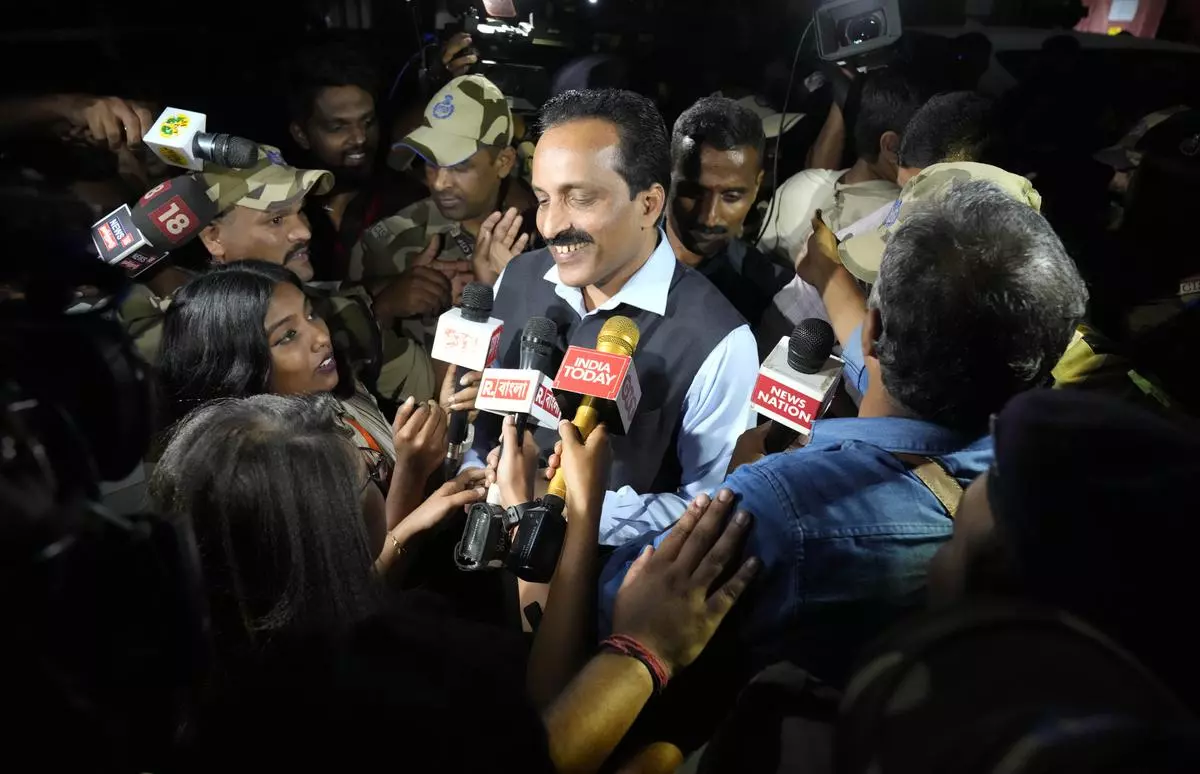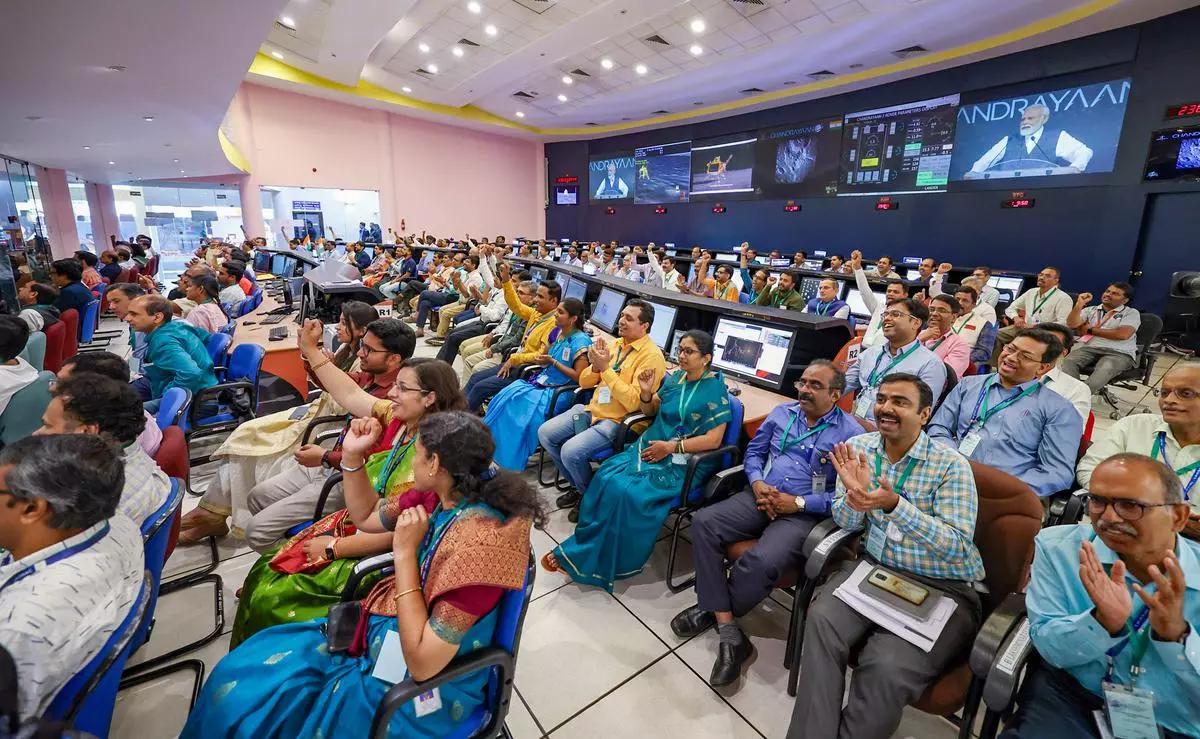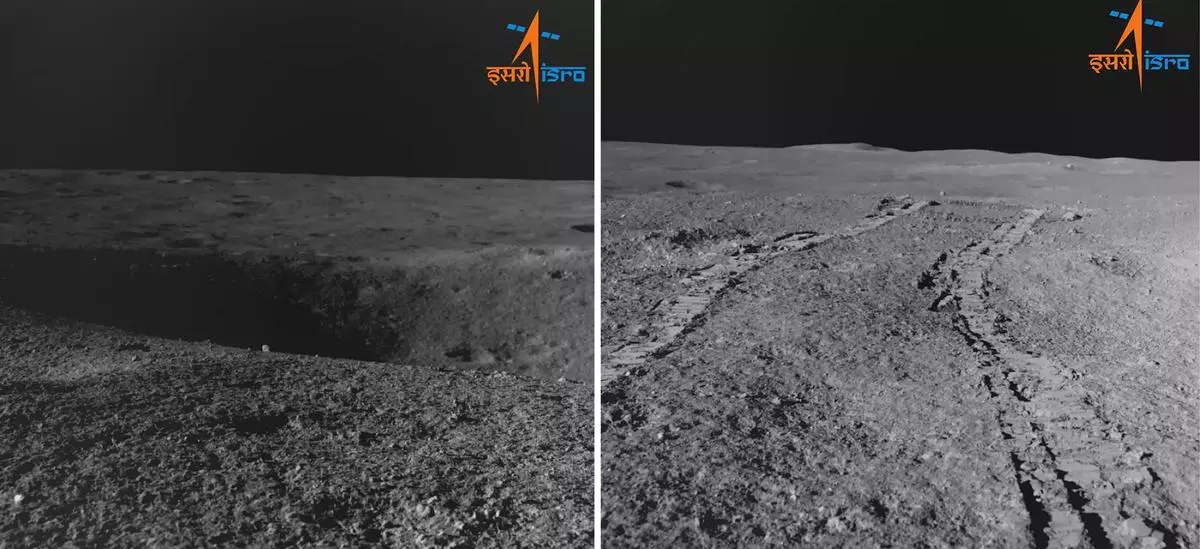Nineteen minutes when all eyes were riveted on their screens; 19 minutes when India’s Vikram landed on a side of the moon where nobody has gone before. India’s moon mission, Chandrayaan-3, achieved the softest of landings for Vikram on the surface of the moon’s near side (facing the earth), near the south pole.
The 19 minutes began at 5:44 pm IST on August 23. It was the moment when, from an altitude of 30 km above the moon, the Automatic Landing Sequence (ALS), a sophisticated computer on board Vikram, took charge of operations based on the instructions it had received some three hours earlier. All that the magnificent crew at ISRO could do now was sit back and hope that their hard work paid off. And pay off it did, with all four stages of the powered descent—rough braking, altitude-hold, fine braking, and terminal descent—going off flawlessly.

ISRO Chairman S. Somanath speaks to mediapersons after the success of the Chandrayaan-3 moon mission, at the ISTRAC facility in Bengaluru on August 23.
| Photo Credit:
AIJAZ RAHI/AP
Vikram cut a 750 km arc from 30 km above the surface of the moon before touching down, but not before hovering a few metres above the lunar soil to study the landing site through an onboard camera that took pictures of the rocks and craters around it, then moving just that bit away to find the best spot, and finally touching down on the lunar soil ever so lightly. The time: 6:03 pm.
At the Spacecraft Control Centre of the Mission Operations Complex at ISTRAC, ISRO’s tracking centre in Bengaluru, there was jubilation when ISRO Chairman S. Somanath formally confirmed the successful space odyssey. India had become the fourth country after the erstwhile Soviet Union, the US, and China to soft-land on the moon.
The applause had hardly died down when the scientists prepared for the next phase of the mission: the release of the rover, Pragyan, from the lander. That happened a little after 12:00 am IST when the frangibolts, a device that held the door of Vikram in place, were blasted and the door deployed itself as a ramp on the lunar surface, revealing Pragyan, which was fastened to the inner side of the door with coils. On being heated, the coils melted and snapped to let Pragyan roll slowly down the ramp on to the lunar surface on six aluminium wheels.
Moving about a centimetre a minute, Pragyan began its exploration of the moon and showed itself to be in good health. Immediately after Somanath said: “We achieved most of the nominal conditions required for the landing, including the velocity of the touchdown. The velocity was less than 2 metres per second and so it gives us a lot of confidence that the health of Pragyan should be good…. We are looking for 14 exciting days from now.” Fourteen days because that is how long the sun will shine on the moon, equivalent to one earth day, before darkness sets in for the next 14 days when the temperature could go down to -150 degrees C at its poles. Pragyan will be switched off during this period, and once the sun shines again ISRO may try restarting it.

Scientists of ISRO celebrate the success of Chandrayaan-3 at the ISTRAC command network, in Bengaluru on August 26.
| Photo Credit:
ANI
Technological challenge
Vikram’s landing on the moon was among the toughest technological challenges for the space scientists because its orbital velocity had to be brought down to zero before it could be brought down safely, as B.R. Guruprasad, a former ISRO scientist, said. Vikram was travelling at a velocity of 6,000 km per hour. V. Narayanan, Director of ISRO’s Liquid Propulsion Systems Centre (LPSC) said: “From 6,000 km per hour, we had to bring down the velocity to zero over a distance of 750 km in 19 minutes. This job was done by our propulsion systems along with other systems. So, we landed perfectly.”
On its lunar roll Pragyan lost no time as its cameras got to work, taking pictures of the moon’s surface and streaming them to the earth. There were magnificent pictures of Vikram too. The two instruments on Pragyan—Laser-Induced Breakdown Spectroscopy and the Alpha Particle X-ray Spectrometer—were hard at work too. LIBS has discovered “sulphur in the region unambiguously, something that was not feasible by instruments on board orbiters”, ISRO said in a statement on August 28.
Also Read | Chandrayaan-3 success puts India’s ‘rocket women’ in the spotlight
A day earlier Pragyan showed that it knew what a crater looked like. It spotted a 4-metre-wide one from 3 metres away and made the smart choice, change course. It demonstrated another instance of perfect navigation when it avoided a deeper crater.
ISRO also put out a report that a preliminary analysis had indicated the presence of aluminium, iron, calcium, chromium, and titanium on the lunar surface. Additional measurements found manganese, silicon, and oxygen. “Thorough investigation regarding the presence of hydrogen is under way,” it added.
The Alpha Particle X-ray Spectrometer will help to derive the chemical composition of the moon’s topsoil, which will ramp up scientists’ understanding of the lunar surface.
Vikram is also busy at work with the three onboard instruments: RAMBHA (Radio Anatomy of Moon Bound Hypersensitive ionosphere and Atmosphere), which will study the “charged atmosphere of the moon”; ChaSTE (Chandra’s Surface Thermophysical Experiment), which will study the thermo-physical properties of the regolith (Oxford dictionary: the layer of unconsolidated solid material covering the bedrock of a planet); and ILSA (Instrument for Lunar Seismic Activity), which will study seismic activities on the moon. All this Vikram will do from the Shiv-Shakti point, the name given by Prime Minister Narendra Modi to the soft-landing spot.

(Left) A crater that the Pragyan rover encountered on August 27 and (right) the path retraced by it on the lunar surface, as seen by the navigation camera on board.
| Photo Credit:
ISRO
Propulsion module
The entire mission was made possible by a very important piece of space-faring equipment, the propulsion module, to which Vikram was attached before it made its 19-minute tryst with lunar destiny.
The propulsion module, which as it circled the moon had a payload to study the earth’s spectral emissions; the lander module; and the rover together made up the Chandrayaan-3 ensemble. The propulsion module weighed 2,145 kg, and Vikram 1,750 kg, including the 26-kg Pragyan. The entire craft weighed a little less than 4 tonnes. Vikram was 250 kg heavier than the lander in Chandrayaan-2 because this mission does not have an orbiter.
In Somanath’s view, the first critical event in the entire mission, and its most difficult part, was the launch of the LVM3-M4 itself, bearing aloft the Chandrayaan-3 module. The second critical event was the capturing of the craft by the moon’s gravity. “If you miss it by your calculation, it is gone. You cannot retrieve it,” he said. The third critical event, he said, was the separation of the lander from the propulsion module. It happened at the appropriate time. “This happened after the craft spent so many days in orbit. The mechanism should work without any problem. The last critical event was—well, you watched it along with us. That is it.”
Chandrayaan-3 has had the benefit of learning from two earlier missions, Chandrayaan-1 (2008), which was an orbital mission that crashed a Moon Impact Probe on the moon, and Chandrayaan-2 (2019), in which the lander misfired in the last few minutes and crashed on the lunar surface.
Highlights
- The Vikram landing was among the toughest technological challenges for ISRO.
- A preliminary analysis indicated the presence of aluminium, iron, calcium, chromium, and titanium on the lunar surface.
- Chandrayaan-4 could be a sample-return mission.
- ISRO successfully launched its solar mission, the Aditya L-1, on September 2.
Landing on south pole
But why did India choose to land on the lunar south? Former ISRO Chairman K. Sivan explained this in 2019: “ISRO picked the south pole owing to convenience, communication, and science. The rover depends on solar panels to charge its battery, for which good visibility and plenty of sunlight are available in the south pole. Also, the south pole does not have a slope of more than 12 degrees as the lander would topple otherwise. There is also a better chance of ice being present.”
The trip to the moon took around 40 days. In this period, the rocket and spacecraft technologists in the various centres of ISRO exuded a quiet confidence secure that they had a very capable launch vehicle, Launch Vehicle Mark-3, with an enviable record (seven launches, all successful). The country’s most powerful rocket, LVM3-M4 rose from the second launch pad at Sriharikota, a spindle-shaped island in Andhra Pradesh, and vaulted into the sky on July 14, with the Chandrayaan-3 module resting in its cone.
Also Read | The unsung heroes behind ISRO’s successful moon landing
It was a textbook launch with the three stages firing on time and jettisoning on the dot. About 18 minutes into the flight, the propulsion module moved into a geo-transfer orbit around the earth, with an apogee (farthest point) of 36,500 km and a perigee (nearest point) of 170 km. In the first orbit-raising manoeuvre, on July 15, the liquid apogee motor in the propulsion module fired to perfection to achieve an apogee of 41,762 km and perigee of 164 km.
Over the next few days, the orbit was raised gradually until, on August 1, it was time for the trans-lunar injection, a slingshot procedure that put the propulsion module on its path to the moon.
Four days later, on August 5, the spacecraft was inserted into the lunar orbit, which essentially involved getting captured by the moon’s gravity, a precision manoeuvre where one misstep would have meant losing the craft in space. The propulsion module’s orbit was circularised around the moon before the next big moment arrived—the separation of Vikram from the propulsion module, on August 17.
All through this journey, ISRO released images from the moon taken by highly sophisticated imaging sensors built at the Space Applications Centre (SAC), Ahmedabad, one of the jewels in ISRO’s crown of establishments. Among the instruments it has developed is a microwave altimeter that gives accurate information about the height of the craft above the moon, said Kiran Kumar, who was SAC director before he became ISRO Chairman in 2015. It was perhaps needed the most during the last 19 minutes of Vikram’s powered descent.
50 shades of grey
Is the moon coloured or black and white? Well, unlike the planets, the moon’s surface has no brightly coloured areas. Its palette is mostly greys, dark browns, or black. Ordinary photographs cannot capture its few colours, but it is possible for a high saturation image to show green, orange, or blueish tints.
The lighter surfaces are the lunar highlands called terrae, while the darker areas (mostly lowlands) are called maria. The terrae are iron-poor and calcium-rich, which is why they are lighter. The maria are abundant in basalts or dark volcanic rocks rich in magnesium and iron.
Some parts of the moon, called permanently shadowed regions, never see sunlight. They appear dark because unlike on earth the axis of the moon is nearly perpendicular to the direction of the sun’s light.
Conceptualisation
The Chandrayaan saga, which was initially conceptualised as a one-off mission, had an interesting start to it, best heard in the words of M. Annadurai, Project Director of Chandrayaan-1: “The project report was sent to Prime Minister Atal Bihari Vajpayee. The Prime Minister, while appreciating the concept and effort, added ‘-1’ to Chandrayaan. That was an indication that there would be a series [of Chandrayaan missions].”
Chandrayaan-1 entailed sending a spacecraft to orbit the moon. A.P.J. Abdul Kalam, who was a rocket technologist before he became President, suggested that ISRO send a probe aboard the orbiter and that the probe could crash-land on the moon. That was how the Moon Impact Probe, with the national flag painted on it, was added to Chandrayaan-1, Annadurai said.
With Chandrayaan-2, ISRO wanted to confirm the presence of water ice, and the mission involved a lander and a rover emerging from it. There was the technological challenge of soft-landing on the moon and doing science experiments to understand the lunar surface. But the soft-landing was not to be.
Also Read | Chandrayaan-3 marks India’s emergence as a space power
Chandrayaan-3, as initially conceptualised, was a greater challenge. Annadurai said: “Originally, we thought of Chandrayaan-3 as a sample return mission. It was to be a joint mission with NASA. For some reason, it could not take off.”
He has suggested that Chandrayaan-4 could be a sample-return mission. The rover’s robotic arms could pick up samples of lunar soil, encapsulate them, and hand them over to the lander, which could return to earth. “Russia and the US can collaborate with us provided they take the initiative,” he added.
Aditya solar mission
However, it is the Aditya L-1 (Lagrange point 1) spacecraft that is engaging ISRO’s attention now. The PSLV-C57 rocket successfully launched the spacecraft on September 2 from Sriharikota, and initially put it in an elliptical orbit around the earth, from where it will reach L-1, taking about 120 days in all. Lagrange 1 is a point situated 15 lakh kilometres away, between the earth and the sun and is located in the earth’s orbit around the sun. “From there, the spacecraft will continuously observe the sun, unobstructed by the moon or the earth,” Somanath said. Aditya L-1 will study the sun’s corona, solar flares and winds, and other phenomena.

ISRO’s solar mission Aditya L-1 was successfully launched from Sriharikota on September 2.
| Photo Credit:
ANI
Preparations are also under way for a crew abort mission as part of the Gaganyaan mission, using a test vehicle in the last week of September or in October 2023. Gaganyaan will carry three Indian astronauts in a crew module into space in low-earth orbit, about 250 km above earth. They will spend three days in orbit and conduct experiments.
But for now, it is the time for ISRO to bask in its success and pore over the images that Pragyan is sending from the moon at the end of what has been a truly historic space mission.

